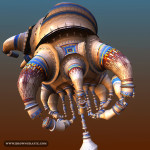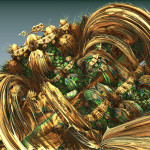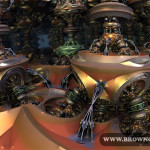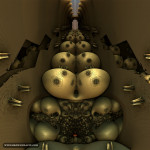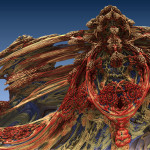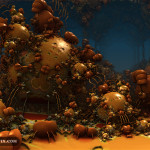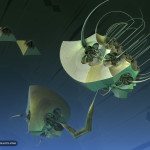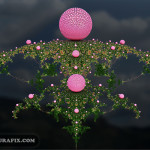Here’s another exercise in strange sound effects. 90% of the audio effects in this Mandelbulb3D animation were created in my kitchen one day as I banged, scraped, and otherwise abused my pots, pans, and silverware for several hours. The other 10% are from the good folks over at www.freesound.org. The fractal itself is a hybrid icosahedronIFS and (as usual) took a long time to render — about three weeks total.
Here’s a silly little horror story I’ve been working on for a few months.
Many, many thanks to my wife and daughter for their reluctant, but well-performed vocal contributions!
Please see the YouTube description for some stats about the rendering process.
Here’s a compilation of a few of my Mandelbulb3d projects that I started working on last year but never quite finished – or simply gave up on. Too many ideas, too few CPUs.
The music is from an old SmartSound fusion collection.
There are a lot of wonderful 2D fractal zooms posted on www.fractalforums.com. Some of the deepest and most amazing zooms posted there are those done by TeamFresh. Inspired, I thought I’d give it a spin (so to speak) and do a zoom in 3D using Mandelbulb3D. Mandelbulb3D currently uses double precision floating point variables which limits zooming to a factor of approximately 15 (beyond this, the fractal image degrades). This means that the maximum bottom frame of a zoom represents approximately 1/(10^15)th [~0.000000000000001] of the area of the first initial frame of the zoom. Because of this limitation, the resulting Mandelbulb3D animation is nowhere near as deep as some of those spectacular 2D zooms go (i.e., 6.066E228!!).
For this particular zoom, degradation of the fractal began at E9. Even so, I still think it turned out kinda nice, if not too brief. Hope you enjoy it.
For the curious, a total of 21000 original frames were rendered over a period of about two weeks (using five PCs). I initially began rendering the frames at 720p resolution (1920×780) but gave up after waiting a week for the first thousand frames to render. Changing to SD resolution (640×480)
sped up the process nicely. The finished collection of 21000 frames was then used to create variously speed-paced sub-collections (i.e., batch 1 = every 3rd frame, batch 2 = every 5th frame, batch 3 = every 10th frame, etc.). These batchs were then used to manually synch the zoom to the
audio without relying on the time stretching functions of a video editor which would have blurred and degraded the digital “crispness” of the rendered frames. In the end, only a total of about 3000 actual frames were used.


